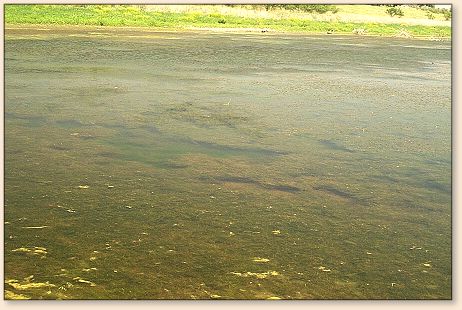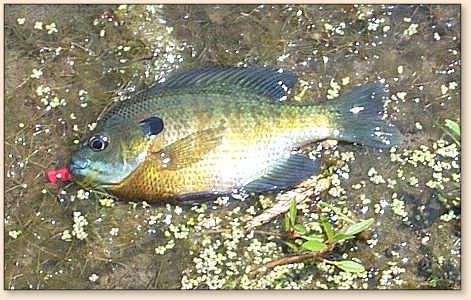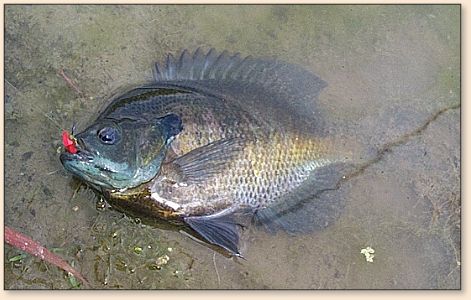|
I learned to fly-fish for trout in the cold
high mountain streams of Colorado. You know,
the ones that a boy of 10 could almost jump
across, much to the chagrin of my mother who
did my laundry. I later graduated to larger
streams and rivers and bought some waders (okay,
my wife did after a few fishing trips when I
returned wet and muddy.) I later moved on to
trying a little lake fishing, so I procured a
float tube. Then my fishing life took a large
turn.
I moved from the Rockies out to the flatlands
of Nebraska. I fought it for about four years,
only fishing a couple of times a year on the
trout stream that is three hours away, but I
finally caved in a couple of years ago and began
chasing the warm water species. That first year
I started it was late in the year when I began,
and it had been a wet year. The lakes were full
and deep. Somehow the place I selected held a
few bluegills and some crappie I was able to catch,
and I have been hooked on warm water fishing ever
since. About that time I also found FAOL and began
digging into any and all information that applied
to this new pursuit.
As I have learned and applied that learning to this
newfound area of my 'hobby' the drought that has been
affecting much of the west also has hit us a bit.
The lakes I fished have lost a lot of surface area.
Last year the shore receded about 20-30 feet in the
areas I frequented. This was actually a blessing to
me and my learning, as I was now able to get out close
to the weed beds that I had heard was where the warm
water species liked to hold. You see, most of the
time I have available for fishing is over my lunch
hour at work. I work five minutes from one lake and
ten from another. I can eat a sandwich and some
carrots while I drive there and string up my rod.
Then I can walk the bank and fish for about 45
minutes before I have to head back. So last year,
with the receding water line I was now able to get
to within 20 feet of the weed edge without getting
wet. I could drop a fly right up next to the weeds
and draw out some of the fish with some regularity.

I had a great year from early March thru late
November of catching crappie, bluegill and bass.
Then this spring arrived. The water has receded
even farther and I now find that the weed beds
start about five feet out from the water's edge.
There are some areas where the weeds do not grow
as close to shore, but they are few and far
between. I again tried fishing the inside edge,
and have picked up a few fish. Most were bass
in the three - to five inch range.
I brought my plight to the attention of my friends
on the bulletin board here, in hopes that they
would have some experience to share and some
techniques for catching more and bigger fish
under these new conditions. They had many
good suggestions. Unfortunately, most involved
getting into the water so I could fish the outer
edges of the weed lines. I would love to give
this a try, and even plan to one of these days
when I can get my float tube out on the lake,
but since most of my fishing is in short time
periods, this has not been possible yet.

One day while I was stalking the banks of the
closer lake (which has the most weed growth)
fishing the spots where the weeds were farther
from shore with limited success, I noticed that
there were many fish hitting the surface out
in the weeds. I thought I had an answer to
the problem; I would just need to tie more of
my flies as weedless configurations and fish
them on top of the weeds. In an attempt to see
what types of flies I would need to tie weedless
I reeled in and watched what was happening a
little more closely. That is when I noticed
something I had not before. Most of the activity
was not really in the weeds, but in and at the edges
of little weedless pockets within the weed beds that
ranged from a few inches in size to a few feet. As
I watched I was amazed that an opening the size of
a dinner plate would have fish regularly hitting
the surface within it.

The next day I decided to try to take advantage
of this newfound knowledge. I headed out to the
same spot, and stood there to see if the same
pattern was holding as the previous day. It was,
so I tied on a small gurgler to see if the fish
would show any interest. I soon discovered that
my casting had a lot to be desired in the accuracy
category. I would slap the fly down on the weed
two feet short of the pocket, or four feet beyond
it, or a foot or two to either side before finally
getting it into the pocket. This seemed to stop
the action in that pocket for a while and I would
have to move on to another one. I kept my attempts
to the bigger pockets as I worked on accuracy and
discovered that if I could place the fly in the
pocket on the first or second try, it would get
some attention from whatever was living there.
Many times this was a bluegill, but there have
been some pretty nice bass (for me) that I have
picked out of these pockets.

It has been a wonderful season of discovery so far
this year, and I hope that I never forget that when
the fishing begins to get difficult I just need to
figure out how to pick the pockets of whatever
body of water I happen to be fishing. ~ dr
|









